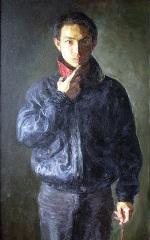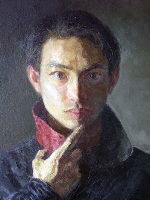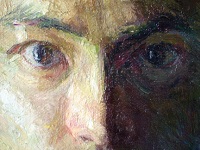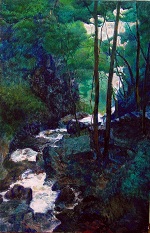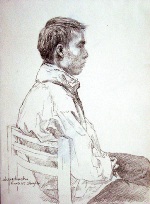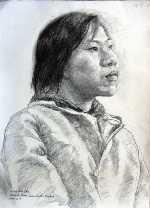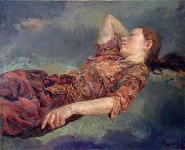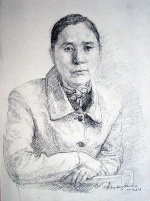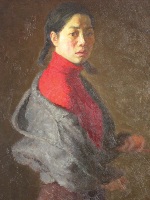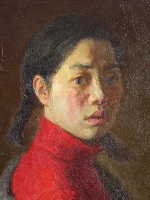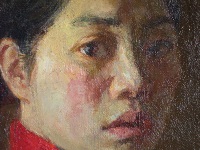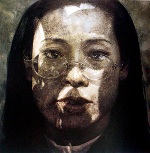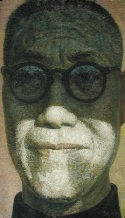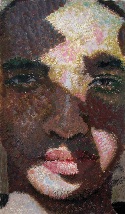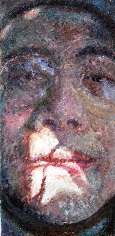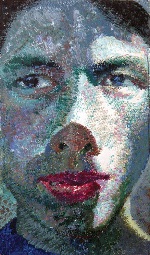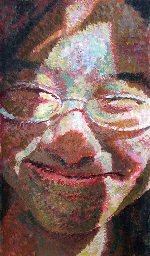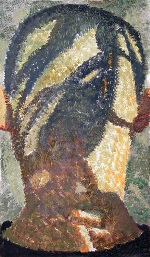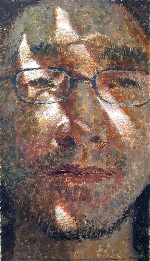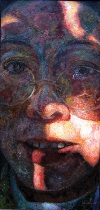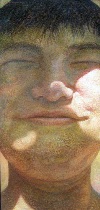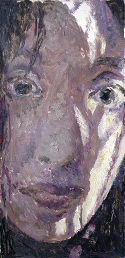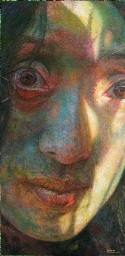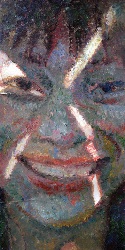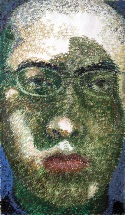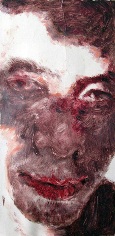Fall 2003, Volume 21.1
Art
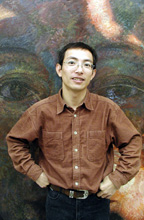
Zhang, Chenchu
New Realism in Contemporary Chinese Painting
Zhang, Chenchu is widely regarded as one of China's most promising New Realist painters.
He has won several major awards in his native country, most recently:
Creative Prize, Central Institute of Fine Arts Graduates
First Prize, Shanghai Young Fine Arts Grand Exhibition
Chinese Young Artist Award, First Beijing International Art Biennale
Zhang's passion for his work is clearly evident in his person and in his paintings. His work has been described as "direct, fresh, and creative without extra decorations." The bold, expressiveness of his work is representative of new directions of contemporary art in China.
Zhang has exhibited extensively in China and is represented in collections in Asia and the United States. He holds a Master of Fine Arts Degree and currently serves Shanghai Teachers University as a lecturer in painting.
Zhang was Weber State University Visiting Scholar during the Autumn Semester of 2003.
We can feel the presence of each Chinese native painted by Zhang, Chenchu. Sharply focused light beams and calculated shadows shape the character of each subject. Zhang paints the people of his own generation, one of great cultural change, and with new emphasis on the importance of the individual in Chinese culture.
—Mark Biddle
Professor of Art, Weber State University
Zhang, Chenchu and The Combination of Three Artistic Styles
When standing before the paintings of Zhang, Chenchu we are immediately attracted to his Impressionistic style. He shares interests with Claude Monet, who expressed himself primarily through landscape subjects, and also with Renoir, who studied the human form in light and color. Zhang's most recent work investigates the wonder of light on closely cropped human faces, and sometimes the backs of heads that are streaked and dotted with sunrays. The sharpness of this detail is balanced elsewhere by soft illumination and delicate color.
The overall effect subtly refers to the character attributes of his subjects and, on deeper levels, discloses the inner landscapes that reside behind those "looks" and the eyes that punctuate them. His forceful compositions lend an element of expressionism to his imagery—the legacy of van Gogh and Edvard Munch.
Zhang, Chenchu's exploration in painting builds upon groundbreaking movements originating in the late 19th Century and exemplifies the New Realist movement in China today. His current trajectory carries forth the traditional Chinese emphasis on beauty in art, and reveals the fresh new face of contemporary Chinese culture.
—Wu, Jingdong
Professor of Philosophy, Shanghai Teachers University
China is a country with a long history of about 5000 years and a splendid traditional culture. From the Tang Dynasty, which began in 618 AD, to the Yuan Dynasty, which ended in 1368, ancient Chinese painting attained brilliant and unparalleled achievements, both in figure painting and landscape painting. This is one of my most important inspirations. Sometimes, when I am painting, I have a feeling that it is not so much a face that I am painting, but a Chinese landscape.
When I teach in Shanghai, I like to draw along with my students. This allows me to play an exemplary role, and it increases the sharpness of my own perception at the same time.
This portrait is based on my experience of studying in Bejing. The neutral color matches Bejing people. They are very stable people who pursue secure positions in life.
This painter had a strong style, and I imitated his style in painting his face. He is painted in primarily light and dark tones to show his strong character. Unfortunately, he was persecuted and died in the 1970s, a victim of the Cultural Revolution.
Since 2000, I have been focusing upon a theme of contemporary Chinese youth portraits in order to show the mental outlook of that generation. This includes myself. I have grown up under a period of great social change. The artwork shown here has caused great interest in China. I think my artwork benefits from the following influences: first, the study of traditional European oil painting has laid a foundation for my modeling ability; second, Impressionism has been a very strong influence in my work; third, contemporary Chinese youth culture has become my primary source of artistic production.
This image represents an active, vocal character. He is a deep, complex thinker. I tried to emphasize this by placing a cross on his mouth and calling attention to his outspokenness and fantastic thoughts. The cross makes us wonder what kind of person he is. We ask, "Why does the artist paint a cross on his mouth?" Then, secondly, "What kind of man is he?"
This is a portrait of a sculptress who has rich thoughts and feelings. Shanghai people are active. Their ideas change frequently, and this person is painted to match the characteristics of her city. I'm exploring something new with the saturated color in this painting.
I painted a series of portraits of the five most famous Chinese painters [see "Pan, Tiam Shou,"]. My purpose was to address the present situation of art in China. Many young artists advance blindly and ignore the wonderful history of traditional Chinese art. These five painters invented something new based on what they had taken from tradition. They are models of the true creative spirit because they didn't just jump straight into western painting. We cannot forget our own heritage. Although we absorb the wonderful culture of the West, we should first inherit the great wealth of Chinese painting, and then invent anew.
This is one of the greatest painters in modern China ["Qi, Bai Shi"]. He lived from 1863 to 1957 and witnessed several periods of change in recent Chinese history. During the liberation of China in the early 1900s, society and culture were unfavorable and dark. He was like a burning light in a dark society, and this can be seen in his art. In a period of turmoil he encouraged people to pursue truth, kindness and beauty. He has been painted with dark color although he appears strong—rock solid in the face of change. This painter had a strong style, and I imitated his style in painting his face.

